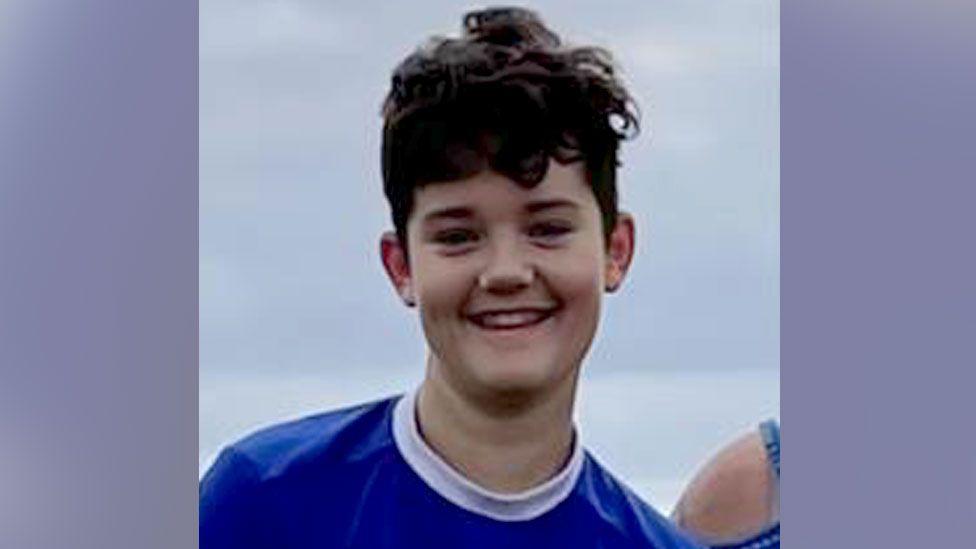Traitors star is 'grateful for abnormal anatomy'

Elen Wyn has previously called on the Welsh government to offer more funding, better information and greater sensitivity to women's health
- Published
The Traitors star and Welsh opera singer Elen Wyn says she is "grateful to have an abnormal anatomy" as it ultimately led to her endometriosis diagnosis.
Appearing on the podcast It's Not JUST a Period!, external, the 25-year-old from Anglesey said doctors discovered she had only one "abnormally big kidney... two wombs and two cervixes".
The condition, known as uterus didelphys, occurs when the uterus fails to fuse during development in the womb and it affects about 0.3% of women, external.
This results in a double uterus, which may also have two cervixes and two vaginal canals.
GPs laughed off Traitors star's endometriosis fears
- Published25 February
Two babies in two days for mum with double womb
- Published23 December 2023
Despite living with the condition her whole life, the recent discovery has left Elen with "so many questions" such as "why do [both the wombs] bleed at the same time?"
The star of The Traitors Series 3, who was eliminated on episode two, previously told the BBC that the pain she suffered was comparable to that of "barbed wire around her stomach".
When her periods began aged 14, she frequently missed school and sat out of sports because of her discomfort.
During her 10-year wait for an endometriosis diagnosis, Elen, originally from Llanfair-yng-Nghornwy, was regularly told it was "just a period", that she had a low pain threshold and on one occasion, was laughed at by a GP.
Elen began suspecting she had endometriosis after watching other people talk about it on TikTok, yet the full extent of her complex condition came to light in a "terrifying" way.
After her second ultrasound, a doctor assumed she knew she only had one kidney, which she did not.
She was referred for an internal ultrasound and recalled feeling extremely anxious when a nurse couldn't locate her cervix and more staff were called in for second opinions.
"So many people were just looking at this screen inside of me and they just didn't understand," she said.
At first, doctors denied she had endometriosis, external - a condition where tissue similar to the womb's lining grows elsewhere in the body - but told her that her anatomy looked "very different" and referred her for an urgent MRI scan.
What is endometriosis?
Endometriosis is a condition where tissue similar to the lining of the womb is found in other areas of the body, such as the ovaries, fallopian tubes and lining of the pelvis.
It also sometimes affects organs, such as the bladder and bowel. Rarely, endometriosis is found in areas outside the pelvis, such as in the chest.
Symptoms include severe to debilitating pain often in the pelvic area, fatigue, and heavy periods, and the condition is also associated with infertility.
Source: NHS
'So many questions'
When doctors were trying to make sense of her uterus didelphys, they questioned whether she had two periods a month, which she hadn't.
"They asked me 'do you use tampons or pads?' and I said both.
"They asked me if I insert a tampon, do I continue to bleed, and I said no," she recalled.
"So it's all normal except from my two wombs."
Elen admitted she was still baffled by the discovery, leaving her with "so many questions".
"What I don't understand is if I have two wombs... why do they bleed at the same time?
"Are they just in sync?
"I'm kind of grateful that I do have an abnormal anatomy because otherwise I wouldn't have found out I had stage 4 endometriosis."
After years of being made to feel dramatic and "constantly gaslit", Elen said the diagnosis was something she "really needed".
What is uterus didelphys?
Uterus didelphys is a rare congenital condition that develops before birth, when the two tubes that normally form a single uterus fail to fuse properly.
Instead, two separate wombs are created - each with its own cervix - and, in some cases, a double vaginal canal.
People with a double uterus are at increased risk of miscarriage and preterm birth but can have healthy pregnancies, external.
Some symptoms include:
Pain during sex
Painful cramping before and during your period
Heavy bleeding during your period
Leaking blood when using a tampon (tampon is only in one vaginal canal and not the other)
Frequent miscarriages
Premature labour
Now that Elen has received her diagnosis, she is waiting for a laparoscopy to surgically remove the endometriosis.
After nine months believing she was on the waiting list, estimated to be six to eight months long, she asked for an update and discovered she was "never referred".
She has now been added to the list, but feels it means the clock has restarted in her bid to get the answers she needs.
More top stories
- Published3 November

- Published2 November

- Published30 October
